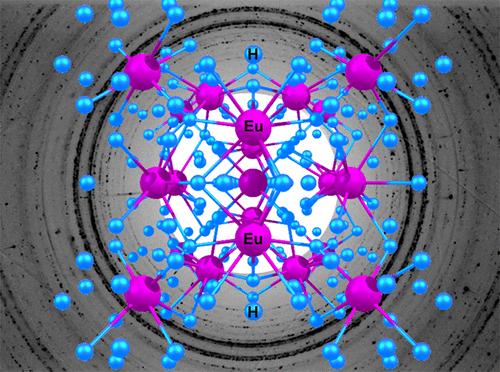Scientists discover a new complex europium hydride

The novel strongly correlated Europium superhydride
Credit: Dmitrii V. Semenok et al/The Journal of Physical Chemistry Letters
A team of researchers from Russia, the United States, and China led by Skoltech Professor Artem R. Oganov has discovered an unexpected very complex europium hydride, Eu8H46. The paper detailing the discovery has been published in The Journal of Physical Chemistry Letters.
Superhydrides of rare-earth metals are interesting compounds that form under pressure: some exhibit high-temperature superconductivity that scientists have been chasing for over 100 years, and some possess magnetic properties. Although devoid of superconductivity, europium hydrides are very interesting in view of chemical anomalies that make europium different from other rare-earth atoms.
Armed with the efficient and reliable USPEX crystal structure prediction tool developed by Oganov and his students, the team predicted the structure of the remarkably complex compound, Eu8H46, which helped understand and explain experimental data.
“I am pleasantly surprised that USPEX has easily predicted a highly complex structure of 54 atoms, which is quite a lot. Curiously enough, our colleagues obtained this hydride in an experiment earlier but got the structure and composition wrong, assuming it was EuH5. Now we know that the compound is much trickier,” Oganov comments.
“Such unusual compounds can be predicted in theory and proved by experiment, but there is no simple rule for identifying probable chemical compositions of stable compounds without performing arduous calculations,” says Dmitrii Semenok, the first author of the paper and a PhD student at Skoltech.
###
Artem R. Oganov is a Professor at Skoltech, a member of Academia Europaea, a Fellow of the Royal Society of Chemistry, a Fellow of the American Physical Society, a Fellow of the Mineralogical Society of America, and a Professor of the Russian Academy of Sciences.
All latest news from the category: Life Sciences and Chemistry
Articles and reports from the Life Sciences and chemistry area deal with applied and basic research into modern biology, chemistry and human medicine.
Valuable information can be found on a range of life sciences fields including bacteriology, biochemistry, bionics, bioinformatics, biophysics, biotechnology, genetics, geobotany, human biology, marine biology, microbiology, molecular biology, cellular biology, zoology, bioinorganic chemistry, microchemistry and environmental chemistry.
Newest articles

A universal framework for spatial biology
SpatialData is a freely accessible tool to unify and integrate data from different omics technologies accounting for spatial information, which can provide holistic insights into health and disease. Biological processes…

How complex biological processes arise
A $20 million grant from the U.S. National Science Foundation (NSF) will support the establishment and operation of the National Synthesis Center for Emergence in the Molecular and Cellular Sciences (NCEMS) at…

Airborne single-photon lidar system achieves high-resolution 3D imaging
Compact, low-power system opens doors for photon-efficient drone and satellite-based environmental monitoring and mapping. Researchers have developed a compact and lightweight single-photon airborne lidar system that can acquire high-resolution 3D…





















